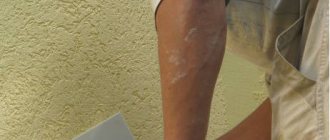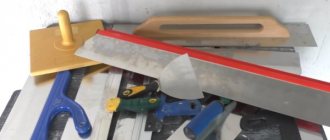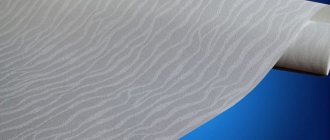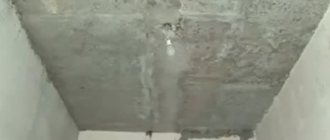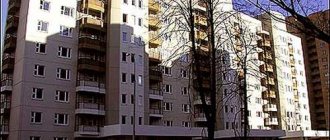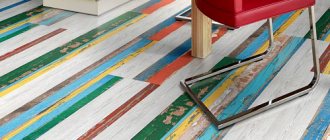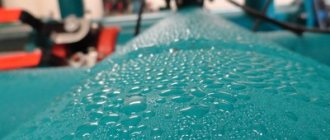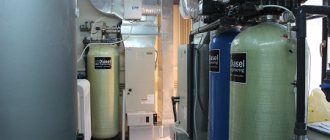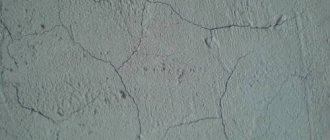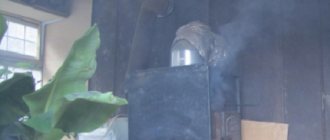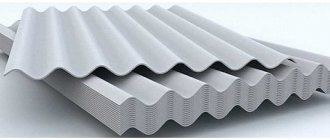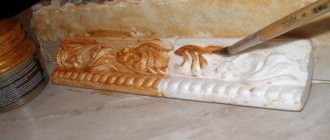Most paints do not adhere well to galvanized metal. What composition should I choose to renew a galvanized roof and how to apply it correctly?
The popularity of galvanized steel roofs is explained by their lightness, ease of processing, strength, reliability and affordability. The metal surface is protected from oxidation in air and corrosion by a thin layer of zinc, which provides reliable and long-term protection for 10–15 years. But the service life of the material ranges from 15 to 50 years. It depends on various factors: the thickness of the steel, the amount of alloying impurities, the thickness of the zinc coating and the technology of its application. Due to exposure to UV radiation, rain, snow, salts, exhaust gases, the zinc layer becomes thinner over time. Local damage forms on it, and the roof becomes less protected from corrosion.
The easiest way to increase the service life of a galvanized roof, as well as gutters, flashings and other elements made from this material, is painting. But the vast majority of paint and varnish coatings have poor adhesion to galvanized surfaces. Conventional paint interacts with the zinc layer and does not form a strong and durable protective and decorative coating. Therefore, specialized compounds are required for galvanized iron. Their main advantages: increased adhesion to metal, high anti-corrosion properties, water and frost resistance, elasticity. And the country house itself will look brighter and more attractive with a change in the color of the roof.
Pay attention to specialized compounds intended for galvanized iron. Painting can extend the life of a galvanized roof by up to 35–40 years.
Why do you need to paint a galvanized roof?
Oddly enough, asking the question of how important it is to paint a galvanized roof often confuses future owners. A very popular myth among car lovers and handicraftsmen is that galvanized metal, even under extreme conditions of city streets, does not begin to rot and rust. For this reason, we can say formally, there is no reason to paint galvanized roofing.
In reality, the situation with galvanized roofing is much more confusing and complex:
Zinc is a metal that is relatively soft, which is why, during transportation and installation, scratches with a depth of up to 0.01 cm are formed on the galvanized surface.- The galvanized roof surface will be less resistant to the abrasive effects of wind with raised dust and fine sand.
As a result, due to the friction of sand, bald stripes are formed on the shiny surface of the metal, and even more so in the area of the ridge, roof overhangs and eaves without galvanized protection. If you do not paint the roof in time, a whitish coating will quickly form, and further stopping the corrosion process will be very difficult.
Please note that after the galvanized layer is erased with an abrasive, rust will begin to get under the protective layer, and therefore the dimensions of the affected surface can be much larger than the visible type of stain.
The shiny initial galvanization of a standing seam roof gives the overall structure a festive look, although most owners prefer more natural or natural colors instead of galvanized, for example, the paints of fired tiles or the colored colors of a bitumen roof. This is an additional method of painting a galvanized steel roof, especially since the sooner you start painting, the more durable the decorative layer will be.
Preparing the foundation
The surface must be cleaned before painting.
In order for a painted roof to last for a long time, in addition to choosing the right paint, it is important to prepare the galvanized surface for applying paint. First of all, remove accumulated dirt, grease, as well as salt stains or so-called “white rust”. It is formed as a result of the interaction of moisture and zinc and indicates the beginning of metal corrosion. Minor stains can be removed with household cleaners. Small pockets of “white rust” are cleaned off with a sponge or soft brush, and in case of extensive deposits, a steel brush or abrasive tool is used. After which the surface is thoroughly washed with water and allowed to dry. Apply primer or paint to a clean and dry surface.
Features of painting galvanized roofing
You can paint a galvanized iron roof using different methods; the tools and techniques for painting are almost no different from those used when applying a paint coating to a simple metal surface, for example, when painting a metal gate or a fence made of black steel. But zinc is a complex metal; its structure is such that, regardless of the method of application to thin steel sheets, the galvanized surface will be formed from a large number of microscopic crystals. If you touch a galvanized surface with your fingers, the thin zinc film will seem slightly greasy, as if a little silicone grease had been applied to it.
Sometimes bad craftsmen, before painting a galvanized roof, treat the metal with a solvent in the same way as is done when applying paint and varnish to plain black steel. As a result, the paint and varnish material lies unevenly on the roofing surface, and it often even begins to roll off in microscopic drops. For this reason, before painting galvanized iron roofing, you will need to at least properly prepare the surface and carry out a treatment that increases the adhesion and stability of the paint base.
How to paint galvanized iron on a roof
So, what paint should you use to paint the galvanized roof of your house? The most difficult question will be the choice of paint and varnish materials that are suitable for painting seam type galvanization. Naturally, you can only purchase a special paint and varnish composition marked “for galvanized surfaces” and fully trust the experience of the manufacturer of paints and varnishes.
The paint for such a roof must satisfy at least 3 conditions:
- Have a high degree of adhesion to galvanized coating.
- The paint and varnish material should not interact with zinc.
- The layer of paint and varnish material must have a high degree of strength and elasticity, not crack or peel under conditions of thermal expansion of galvanized roof metal.
But the special protective agents that are used for galvanized roofing coatings in industry are very expensive. For this reason, a dilemma arises - to use an available special mixture for zinc or to paint galvanized roofs with the most beautiful branded paint.
Applying paint
Painting is most often done using a roller or wide brush. The roller is better suited for processing large and flat areas. The brush is useful for processing small parts. Working with a brush allows you to get a more uniform coating. You can also use a spray gun if you have the skills to handle this equipment.
The optimal temperature of the material to be painted is from 10 to 40 degrees above zero. Humidity should not exceed 75-80%. It is not advisable to paint on hot summer days, as an overheated base will cause uneven polymerization.
Before starting work, the paint and varnish material should be stirred well, and this should be done periodically and then during the work process. If an aerosol can is used, shake it for 20-30 seconds before starting work.
Paint is applied in two or three thin layers. If the layers are too thick, streaks will appear. Each subsequent layer can be applied only after the previous one has polymerized. The drying time of the paint is indicated by the manufacturer on the packaging.
What not to paint
Roofing materials that have a protective coating should not be painted with paints containing high levels of alkaline soaps or acid salts, commonly used in paints to improve adhesion and convert rust into iron phosphate. Unlike steel, the zinc layer quickly dissolves with the formation of amphoteric compounds, due to which the paint and varnish material peels off and comes off the roof surface along with the galvanized coating. Another limitation is the presence of special toners or pigments in the paint based on powdered tin, copper or antimony. If you paint galvanized steel with a paint and varnish material containing copper pigment, even in oxidized form, the process of degradation of the roof covering will still occur, although at a much lower rate than with direct contact with copper.
In the heat the work is progressing
Optimal conditions for painting a metal roof: temperature - not lower than 5°C and air humidity - not more than 80%. Please note that the drying time of paint is affected not only by temperature and humidity, but even by strong winds. It is undesirable to start the process in the summer when it is very hot, when a metal roof can heat up to 40°C or higher. In this case, the solvent included in the paint will dry quickly and will not be able to provide sufficiently strong adhesion of the layer to the metal. In this case, pores and bubbles will form inside the coating. It is equally important to finish the job so that the paint has time to dry before the evening dew falls. The freshly applied coating may become dull due to condensation formed on the roof surface.
Review of materials
Acrylic paints
The most popular materials for galvanized roofs are those based on water and alkyds. Polymers and acrylates based on them have the least degree of corrosion activity towards zinc, and therefore paints of this class can be used to paint standing seam roofs in bright colors. But the adhesion strength of acrylic coatings to galvanized metal is low, since they can be used for small parts, for example, additional elements. For example, paint and varnish material with the brand “Tsirkol” and its analogues can be applied using a spray gun, a brush or a simple paint roller. For full-size roof slopes that are covered with iron, it is better to use composite mixtures of acrylic-type resins and cyclohesanone-formaldehyde, which are dissolved in a polar solvent, usually based on butyl and ethyl alcohol. Zinc and aluminum powder are used as coloring pigments.
Please note that if the metal from which the filler toner is created is placed to the left of the zinc in the range of electrical voltages or potentials of the metal, then a galvanic couple will not form.
In this sense, aluminum is the best material, because due to the oxide film it will not exhibit activity when in contact with solvents. A good choice of paint and varnish material for new galvanized roofs is Serebrol, which has a semi-matte sheen. To achieve high quality coating, painting a galvanized roof with two layers of enamel is enough. The Belarusian paint MAV BASTION KR-12 has an excellent reputation.
Polyurethane coatings for galvanized roofs
Coatings based on polymer urethane resins can be considered more resistant to external loads. Experts advise using polyurethane paint and varnish compositions in cases where there is a large amount of ice, sand and other materials on the roof that have an abrasive effect on the galvanized coating. How to paint a rusty galvanized roof of a house? Alkyl-urethane and polyurethane paints and varnishes retain color well, and are considered to be the best materials to use for painting worn out old roofs. For example, inexpensive UNIKOM paint fits perfectly on the roof and stays on a metal roof worn to holes, even if traces of galvanized coating remain on the surface. And before using the most popular Tsikrol paint, it is better to pre-paint the roof with a primer that improves adhesion to zinc.
Alkyd and composite coatings
If the roof of a galvanized type house is exposed to strong gusts of wind, or there are other unfavorable conditions that negatively affect the condition of the roof, then it is best to use more modern versions of paint-and-varnish coatings based on urethane and epoxy resins to protect galvanized metal. For example, you can use the same “Serebrol” based on epoxy and perchlorovinyl resins. This product is perfect not only for standing seam roofing, but the material is ideal for painting galvanized drainpipes and gutters. This way you can reduce the wear of the drainage part by almost 3 times. alkyd enamels are used for painting roofs in limited quantities. And although a roof painted with an alkyd-urethane composition looks quite beautiful, the paint coating does not adhere so firmly to a galvanized surface. For this reason, to paint zinc, you need to buy an additional primer or use more expensive 3-in-1 compositions, with an adhesive primer, a corrosion inhibitor and a shine former.
Helpful advice! If you have a choice, it is best to paint galvanized surfaces with paints and varnishes in light colors, without pigments based on iron and copper oxides. This not only improves the protection of the coating, but also hides light spots of zinc that have oxidized.
Purposes of coloring
Galvanized sheets are coated with an oil layer at the factory, which protects the metal from environmental factors. However, most often, within a year or a year and a half, the layer gradually disappears due to precipitation. This is why it is recommended to paint galvanized steel. This approach will solve the following problems:
- Corrosion protection.
- The appearance of the roof will become more attractive, especially since the color can be chosen in accordance with the style of the building.
- Despite the fact that painting costs money, the financial costs in this case will still be less than if you have to replace the roof ahead of schedule.
Recommendations and tips
The maximum surface area can only be obtained in calm weather, and therefore the best time to paint the roof is a calm autumn morning. Cleaning and preparing the roof surface can be done in the evening before work. The second layer is applied to the metal in the evening, and then the surfaces are thoroughly dried. During this time, you need to inspect the applied first layer and identify places, as well as flaws that require touch-up. The last thing to do is paint the elements of the ridge and drainage system.
